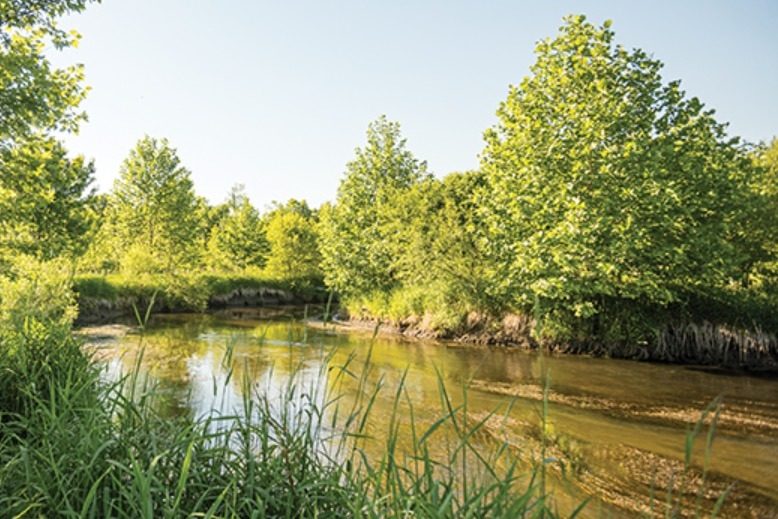
FOUR NEW JERSEY NATIVES
Stumped about what trees to plant on your property? Ecologist Jean Epiphan of Rutgers University suggests natives to restore biodiversity and promote our natural New Jersey heritage.
The four here can tolerate urban conditions, provide nectar and pollen for native bees and butterflies, and are host sites for beneficial insects. “People like songbirds,” says Epiphan, the research project coordinator at the Rutgers Center for Urban Environmental Sustainability. “But you won’t see them if they don’t have caterpillars to feed their young.” Here are four natives to consider:
Swamp white oak (Quercus bicolor). A tree so tough, 400 grown in a New Jersey nursery were planted at Memorial Plaza at the World Trade Center. “It’s great for urban areas,” says Epiphan. “It tolerates backyards where landscapers compact the soil with their mowers.” This oak is also slow growing. “People are afraid of planting an oak because they get large,” says Epiphan. “But you’re planting it to support the local ecosystem. You won’t be around in 100 years when it may need pruning.”
American holly (Ilex opaca). Deer resistant, slow growing and evergreen, American holly makes for a great screening tree that provides bright-red winter berries favored by birds, provided you have at least three female plants for every male. It thrives from coastal forests in Cape May to north Jersey forests. But with hundreds of cultivars, it’s difficult to find at standard nurseries. Epiphan recommends shopping native-plant nurseries like Pinelands Direct Native Plants in Columbus.
Black gum (Nyssa sylvatica). Black gum is often overlooked and not common in suburban landscapes. “But its popularity is growing,” she says. “It’s nice to bring into your yard because it supports wildlife species, and come fall, it’ll stand out with its red foliage.”
Bitternut hickory (Carya cordiformis). Most hickories don’t tolerate flooding and soil compaction, says Epiphan, but bitternut hickories are different. “I’ve found them growing in landfills,” she says. Despite beautiful yellow fall foliage and resistance to most diseases, hickories developed a bad rap due to deep taproots, which makes them difficult to transplant. Epiphan recommends small specimens grown in tubes. “It’ll look like a stick coming out. But in a few years, it’ll be a beautiful tree.”
[RELATED: Meet the Handful of Locals Rescuing Our State’s Threatened Trees]
MORE TREE TIPS
We wouldn’t want you to bark up the wrong tree when it comes to planting. To that end, we’ve compiled tips from two Rutgers experts: Jason Grabosky, a professor of urban forestry, and Jean Epiphan, an ecologist and licensed tree expert at Rutgers University.
Choose young trees. “A lot of people want instant gratification. They want a tree to be big right away. But it’s worth it to buy small,” says Epiphan. “It’s cheaper, and it’s worth it for the tree’s health. Research suggests that if you plant a small tree, it’ll be healthier later in its life because it has less stress during its establishment period.”
Match the tree to your site. “Say my backyard is dry, with full sun, and I plant a species of birch there that’s built for being in dappled shade with access to a lot of water. That tree will be stressed for water and will put out organic chemicals that actually attract pests like birch leafminer and bronze birch borer,” says Grabosky. Insects, he points out, “key in on stressed plants.”
Plant at the correct depth. “Most people plant trees too deep,” says Grabosky. “The first root should be visible at the surface of the soil. Better a little too high then too deep.”
Select from locally grown trees. “When possible, purchase trees grown from seeds or cuttings collected within a couple hundred miles of the planting site,” says Epiphan. “Local origin, or progeny, ensures that the tree is adapted to weather and soil conditions at the planting site. These are living things that have evolved to their location.”
Ask for trees by their scientific names. “If you don’t know the Latin name and see it on the label, you don’t really know what you’re getting,” says Epiphan. Ironwood, she points out, is a common name for several different trees. “If you request an Ironwood without using the scientific name, there is no certainty of what you will receive.”
Plant a variety of trees. “Diversity in trees yields diversity in insects, birds, everything,” says Grabosky. “It’s important not to pick something that’s really pretty, then becomes faddish. Think more purposefully about what matches your site and what does the job you want it to do.”
